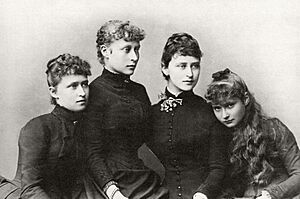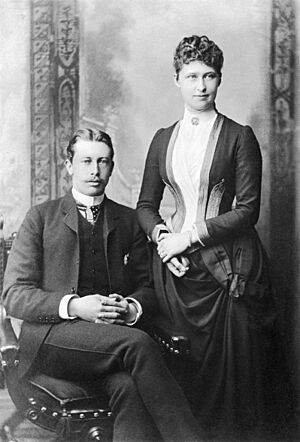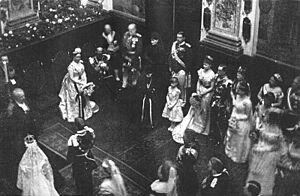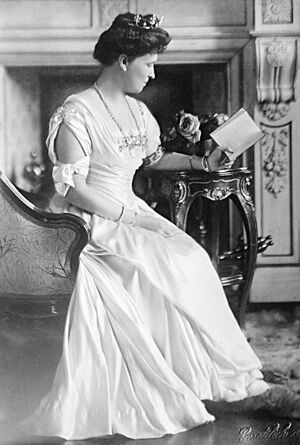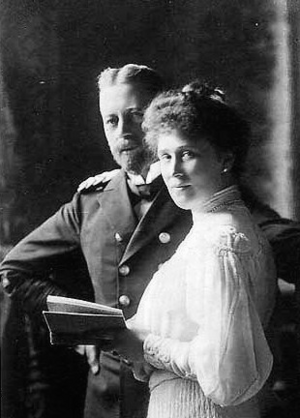Princess Irene of Hesse and by Rhine facts for kids
Quick facts for kids Irene of Hesse and by Rhine |
|||||
|---|---|---|---|---|---|
| Princess Henry of Prussia | |||||
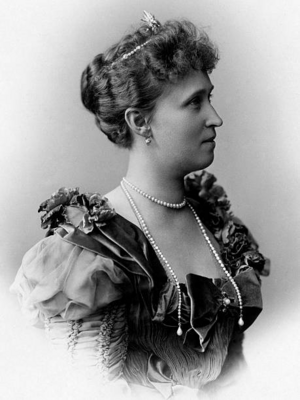
Princess Irene, 1898
|
|||||
| Born | 11 July 1866 New Palace, Darmstadt, Grand Duchy of Hesse, German Empire |
||||
| Died | 11 November 1953 (aged 87) Schloss Hemmelmark, Barkelsby, Schleswig-Holstein, West Germany |
||||
| Burial | 15 November 1953 Schloss Hemmelmark, Barkelsby, Schleswig-Holstein, Germany |
||||
| Spouse | |||||
| Issue | Prince Waldemar Prince Sigismund Prince Henry |
||||
|
|||||
| House | Hesse-Darmstadt | ||||
| Father | Louis IV, Grand Duke of Hesse and by Rhine | ||||
| Mother | Princess Alice of the United Kingdom | ||||
Princess Irene of Hesse and by Rhine (born Irene Luise Marie Anne; 11 July 1866 – 11 November 1953) was a German princess. She later became Princess Henry of Prussia when she married. She was the third child of Princess Alice of the United Kingdom and Louis IV, Grand Duke of Hesse and by Rhine.
Her grandparents on her mother's side were Queen Victoria and Prince Albert of Saxe-Coburg and Gotha. Her grandparents on her father's side were Prince Charles of Hesse and by Rhine and Princess Elizabeth of Prussia. Irene married Prince Henry of Prussia. He was a younger brother of Wilhelm II, German Emperor and also her first cousin.
Irene had several siblings. These included Princess Victoria of Hesse and by Rhine, Grand Duchess Elizabeth Feodorovna of Russia, Ernest Louis, Grand Duke of Hesse and by Rhine, and Empress Alexandra Feodorovna of Russia. Like her youngest sister, Empress Alexandra, Irene carried the gene for hemophilia. This is a condition where blood does not clot properly. Irene's sisters, Alix and Elisabeth, were later killed in Russia during the Bolshevik Revolution.
Early Life
Princess Irene was born at the end of the Austro-Prussian War. She was given the name Irene, which means "peace" in Greek, because of this. Her family often called her "Nin." Her mother, Princess Alice, thought Irene was not as pretty as her sisters. However, Irene was known for her pleasant and calm personality.
Princess Alice raised her daughters in a simple way. They had an English nanny and ate plain meals. The girls learned how to do housework, like baking, making their beds, and cleaning their rooms. Princess Alice also taught them to help the poor. She often took them to visit hospitals and charities.
In 1873, a sad event happened. Irene's younger brother, Friedrich, who had hemophilia, fell from a window. He died hours later from bleeding in his brain. After his death, their mother often took the children to his grave.
In 1878, Irene, her father, and most of her siblings became sick with diphtheria. This was a serious illness. Her youngest sister, Princess Marie, died from it. Their mother, Princess Alice, also got sick while caring for them. She died on 14 December 1878.
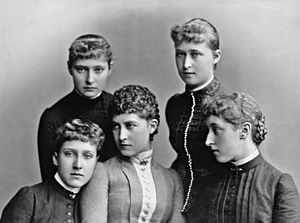

After her mother's death, Queen Victoria became like a mother to her Hessian grandchildren. Irene and her siblings spent holidays in England every year. Queen Victoria sent instructions to their governess about their education and even their clothing. In 1885, Irene and her sister Alix were bridesmaids at the wedding of their aunt, Princess Beatrice of the United Kingdom.
Marriage and Family
Irene married Prince Henry of Prussia on 24 May 1888. The wedding took place at the chapel of the Charlottenburg Palace in Berlin. Since their mothers were sisters, Irene and Henry were first cousins. Their marriage made Queen Victoria unhappy because she was not told about their plans until they had already decided to marry.
At the time of their wedding, Henry's father, the German emperor, was very ill. Less than a month after the ceremony, Irene's cousin became Kaiser Wilhelm II. Henry's mother, Empress Victoria, liked Irene very much. However, she was surprised that Irene did not cover her pregnancy with a shawl. Irene and Henry were a very happy couple. Their relatives called them "The Very Amiables" because of their kind personalities. They had three sons together.
Children
| Name | Birth | Death |
|---|---|---|
| Prince Waldemar Wilhelm Ludwig Friedrich Viktor Heinrich of Prussia | 20 March 1889 | 2 May 1945 |
| Prince Wilhelm Viktor Karl August Heinrich Sigismund of Prussia | 27 November 1896 | 14 November 1978 |
| Prince Heinrich Viktor Ludwig Friedrich of Prussia | 9 January 1900 | 26 February 1904 |
Later Years
Irene passed the hemophilia gene to her oldest and youngest sons, Waldemar and Heinrich. She worried about Waldemar's health from when he was very young. She was very sad when her youngest son, four-year-old Heinrich, died in 1904 after a fall. Six months later, Irene's youngest sister, Tsarina Alexandra, had a son named Alexei, who also had hemophilia.
Irene was raised with strong Victorian beliefs about proper behavior. She was easily shocked by things she thought were wrong. When her sister Elisabeth changed her religion to Russian Orthodoxy in 1891, Irene was very upset. She wrote to her father that she "cried terribly" about Elisabeth's choice.
In 1892, Irene's father, Grand Duke Louis IV, died. Her brother, Ernest, became the new Grand Duke of Hesse. In 1894, Irene's youngest sister, Alix, agreed to marry Tsarevich Nicholas. When Nicholas's father died suddenly, Irene and her husband went to St. Petersburg. They attended his funeral and Alix's wedding to the new tsar, Nicholas II. Alix had also changed her religion to Orthodoxy. Even though Irene disagreed with her sisters' religious changes, she remained close to all her siblings.
In 1912, Irene supported her sister Alix when Alexei almost died from complications of hemophilia. This happened at the Imperial Family's hunting lodge in Poland.
World War I started, and it separated Irene from her sisters because they were on opposite sides of the war. After the war ended, she learned that Alix, her husband, their children, and her sister Elisabeth had all been killed by the Bolsheviks.
In the early 1920s, a woman named Anna Anderson appeared in Berlin. She claimed to be Grand Duchess Anastasia Nikolaevna of Russia, who was thought to be dead. Irene visited Anna Anderson but decided that she was not her niece. Princess Irene said:
"I saw immediately that she could not be one of my nieces. Even though I had not seen them for nine years, the fundamental facial characteristics could not have altered to that degree, in particular the position of the eyes, the ear, etc. .. At first sight one could perhaps detect a resemblance to Grand Duchess Tatiana."
Grand Duchess Olga Alexandrovna, who was the murdered tsar's sister, also commented on Irene's visit. She said:
"It was an unsatisfactory meeting, but the woman's supporters said that Princess Irene had not known her niece very well and all the rest of it."
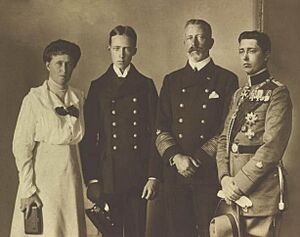
Irene's husband, Henry, said that talking about Anna Anderson upset Irene too much. He ordered that no one should discuss Anderson in his presence. Henry died in 1929. Years later, Irene's son, Prince Sigismund, asked Anderson questions about their childhood. He said her answers were correct. Irene later adopted Sigismund's daughter, Barbara, as her heir. This happened after Sigismund moved to Costa Rica in the 1930s and chose not to return to Germany after World War II.
Honours
 Grand Duchy of Hesse: Dame of the Grand Ducal Hessian Order of the Golden Lion, 21 March 1883
Grand Duchy of Hesse: Dame of the Grand Ducal Hessian Order of the Golden Lion, 21 March 1883 Kingdom of Prussia:
Kingdom of Prussia:
- Dame of the Order of Louise, 1st Division
- Dame of the Wilhelm-Orden
- Red Cross Medal, 1st Class, 22 October 1898
 Kingdom of Bavaria: Merit Cross for Volunteer Nurses
Kingdom of Bavaria: Merit Cross for Volunteer Nurses
 Austria-Hungary: Grand Cross of the Imperial Austrian Order of Elizabeth, 1900
Austria-Hungary: Grand Cross of the Imperial Austrian Order of Elizabeth, 1900 Russian Empire: Grand Cross of the Imperial Order of Saint Catherine
Russian Empire: Grand Cross of the Imperial Order of Saint Catherine United Kingdom:
United Kingdom:
- Queen Victoria Golden Jubilee Medal, 1887
- Royal Order of Victoria and Albert, 2nd Class
See also
 In Spanish: Irene de Hesse-Darmstadt para niños
In Spanish: Irene de Hesse-Darmstadt para niños


